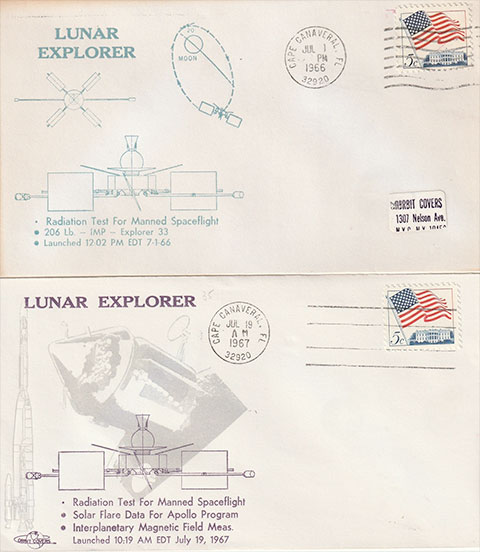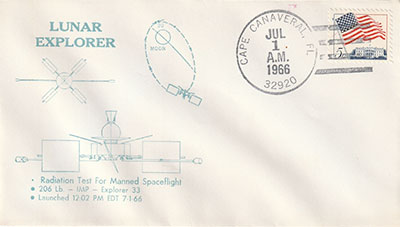|
|

|
|
Author
|
Topic: Space Cover 802: Lunar explorers! Who knew?
|
micropooz
Member Posts: 1846
From: Washington, DC, USA
Registered: Apr 2003
|
 posted 04-20-2025 06:30 AM
posted 04-20-2025 06:30 AM
   
Space Cover of the Week, Week 802 (April 20, 2025) Space Cover 802: Lunar Explorers! Who Knew?This week's Space Cover(s) of the Week are: Orbit Cachet machine canceled at Cape Canaveral on July 1, 1966 for the launch of Explorer 33, "Lunar Explorer" (top), and Orbit Cachet machine canceled at Cape Canaveral on July 19. 1967 for the launch of Explorer 35, "Lunar Explorer" (lower). During the Space Race of the 1960's, the US was sending uncrewed probes to the Moon in droves to prepare for the Apollo Moon landings. Lost in the swarm of the higher profile Pioneers, Rangers, Surveyors, and Lunar Orbiters were a couple of plucky, unheralded Lunar Explorers. The Lunar Explorers measured the radiation environment around the Moon before Apollo started flying humans there. Explorer 33, intended to be the first US spacecraft to enter lunar orbit (the intended lunar orbit is illustrated on the cachet), was launched on a Thor-Delta launch vehicle on July 1, 1966. Unfortunately, the second stage of the launch vehicle didn't fire correctly, eliminating the chance to get into lunar orbit. However, mission controllers devised a plan to use the third stage to put Explorer 33 into a high Earth orbit that crossed the orbit of the Moon. As such, Explorer 33 made four passes by the Moon in 1966, returning usable radiation data from the lunar vicinity. In January 1967 Explorer 33 "blacked out" and mission controllers devised a troubleshooting procedure to bring it back to life. Explorer 33 then soldiered on, returning data until September 1971. Explorer 35, very similar to Explorer 33, was launched on another Thor-Delta on July 19, 1967, and successfully entered a 497-mile x 4780-mile elliptical lunar orbit three days later. This lunar satellite returned data throughout the duration of the Apollo lunar program, finally being deactivated on June 24, 1973. Explorer 35 discovered that the Moon had no magnetic field, that solar wind particles impacted directly onto the Moon's surface, and that the Moon created a "cavity" in the solar wind stream. And most importantly, it showed that the Apollo crews could do their missions without excessive exposure to radiation.
There are other Explorer 33 and 35 covers out there. Let's post your covers for these two unheralded Apollo precursors! |
Axman
Member Posts: 758
From: Derbyshire UK
Registered: Mar 2023
|
 posted 04-20-2025 08:02 AM
posted 04-20-2025 08:02 AM
   
Very interesting, and quite obscure topic Dennis.Here are a couple of SpaceCraft covers for the Lunar Explorers, with artwork by Carl Swanson, classified as #152 and #185 in Charles Vukotich's catalogue.  
Below the covers are the inserts that were sent out by Fitzpatrick to his subscribers. SpaceCraft Covers produced a thousand covers for both Explorer 33 and 35. They were cancelled by machine at Cape Canaveral and Patrick Air Force Base (with some hand cancels at Cape Canaveral for Explorer 35). As are your Orbit Cover examples, both of mine are machine cancelled at Cape Canaveral - it is of interest to note the change in cancellation type between the two launch dates, with straight killer bars replacing the wavy lines in the year's interval between the two missions. I have yet to find a hand cancelled cover, perhaps somebody out there has one (my money would be on Ken!) |
micropooz
Member Posts: 1846
From: Washington, DC, USA
Registered: Apr 2003
|
 posted 04-20-2025 01:31 PM
posted 04-20-2025 01:31 PM
   
Alan asked for a hand cancel, and voila'! I didn't use it in my original submission since the backflap is sealed, giving it that wavy look when scanned. And zounds! First time I've ever beaten Ken at...anything!!!  |
Antoni RIGO
Member Posts: 354
From: Palma de Mallorca, Is. Baleares - SPAIN
Registered: Aug 2013
|
 posted 05-18-2025 04:17 AM
posted 05-18-2025 04:17 AM
   
And now, another cover with Cape Canaveral hand cancel slightly different. AM without dots in time slug. However, rubber stamp cachet is a generic one and not related only to Explorer 33 "Lunar Explorer." | |
Contact Us | The Source for Space History & Artifacts
Copyright 1999-2025 collectSPACE. All rights reserved.

Ultimate Bulletin Board 5.47a
|
|

|
 advertisement advertisement

|

















